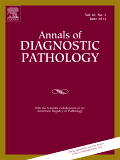
Medical Molecular Morphology
Scope & Guideline
Advancing Understanding in Cellular Structures.
Introduction
Aims and Scopes
- Histopathological Analysis:
The journal emphasizes detailed histopathological studies, including the classification and characterization of tumors and other pathological conditions, using various staining techniques and microscopy. - Molecular Mechanisms in Pathology:
Research that elucidates molecular pathways and mechanisms underlying disease processes, particularly in cancer and degenerative diseases, is a core focus. - Advanced Imaging Techniques:
The use of advanced imaging modalities such as electron microscopy, digital pathology, and immunohistochemistry to study morphological changes at cellular and subcellular levels is a significant emphasis. - Clinical and Case Studies:
The journal publishes clinical case reports that provide insights into unique pathological presentations, contributing to the understanding of rare diseases and their morphological characteristics. - Translational Research:
A strong focus on translational research that connects laboratory findings with clinical applications, particularly in developing diagnostic and therapeutic strategies.
Trending and Emerging
- Digital Pathology:
There is a notable increase in studies utilizing digital pathology, which allows for more precise analysis and storage of histological data. This trend indicates a move towards integrating technology in morphological studies. - Molecular Pathology and Biomarkers:
Emerging research is increasingly focusing on molecular pathology, identifying biomarkers that can predict disease prognosis and treatment response, particularly in cancer research. - Immunotherapy and Tumor Microenvironment:
Research examining the tumor microenvironment and its role in immunotherapy responses is gaining traction, reflecting a broader interest in personalized medicine and targeted therapies. - Stem Cell Research and Regenerative Medicine:
There is a growing emphasis on studies that explore the role of stem cells in regeneration and their potential therapeutic applications, particularly in the context of cancer and tissue engineering. - Machine Learning and AI in Pathology:
The integration of machine learning and artificial intelligence in analyzing pathological data is emerging as a significant trend, promising to enhance diagnostic accuracy and efficiency.
Declining or Waning
- Traditional Morphology Techniques:
There seems to be a decrease in the publication of studies reliant solely on traditional morphological techniques without incorporating molecular or advanced imaging methods. This suggests a shift towards more integrative approaches. - Basic Histological Studies:
The focus on basic histological studies, which do not delve into molecular correlates or advanced analysis, is becoming less common, possibly due to the increasing demand for more comprehensive analyses that include molecular insights. - General Case Reports:
General case reports without significant novel findings or insights into pathology are being published less frequently, as the journal appears to prioritize more complex and informative case studies.
Similar Journals

CARDIOVASCULAR PATHOLOGY
Exploring the frontiers of cardiology and pathology.CARDIOVASCULAR PATHOLOGY, published by Elsevier Science Inc, is a distinguished journal dedicated to the dissemination of high-quality research in the fields of cardiology, pathology, and cardiovascular medicine. With an ISSN of 1054-8807 and an E-ISSN of 1879-1336, this journal has established itself as a vital resource for researchers, clinicians, and students alike. It is positioned in the Q2 quartile for both cardiology and pathology, indicating its significant impact and relevance in these disciplines. The journal offers a platform for innovative studies, reviews, and clinical insights, aiming to enhance our understanding of cardiovascular conditions and their pathological underpinnings. With an H-index that showcases its scholarly influence, CARDIOVASCULAR PATHOLOGY is committed to advancing the field through rigorous peer review and open dialogue among professionals. The journal is accessible through institutional subscriptions, making it an essential reference point for ongoing research through its convergence of knowledge from 1992 through 2024.

CELL STRUCTURE AND FUNCTION
Pioneering Insights into Cellular MechanismsCELL STRUCTURE AND FUNCTION is a distinguished open-access journal published by the Japan Society for Cell Biology, dedicated to advancing the field of cell biology and related disciplines. Since its inception in 1975, and now with open access available since 2017, the journal seeks to disseminate cutting-edge research and reviews that delve into the complexities of cellular structures and their functions. With a notable presence in various categories—ranked Q3 in Cell Biology and Molecular Biology and Q2 in Medicine (Miscellaneous) and Physiology as of 2023—this journal caters to a global audience of researchers, professionals, and students who are keen to explore the latest findings in cellular research. The efforts to foster accessibility and promote scholarly exchange in the field make CELL STRUCTURE AND FUNCTION an essential resource for those looking to stay at the forefront of biological sciences. The journal is indexed in Scopus, marking its relevance and reliability in the academic community. Explore the vast potential of cell biology through this comprehensive platform.

BIOLOGICAL PROCEDURES ONLINE
Catalyzing Discoveries in Biochemistry and Molecular Science.BIOLOGICAL PROCEDURES ONLINE is a premier open-access journal published by BMC, dedicated to advancing the fields of biochemistry, genetics, and molecular biology. With its electronic ISSN 1480-9222 and a strong commitment to accessibility since 2009, this journal provides a vital platform for researchers and scholars to disseminate their findings and foster collaboration within the scientific community. Based in the United Kingdom, this journal has garnered an impressive reputation, achieving Q1 status in the 2023 category rankings, with notable inclusion in the Scopus rankings, placing it in the 86th percentile among 221 peer journals in the general biochemistry, genetics, and molecular biology domain. It covers a broad range of topics, ensuring coverage of the latest advancements and methodologies in biological procedures, making it an essential resource for academics, practitioners, and students alike. Researchers are encouraged to submit their innovative work and contribute to the ongoing dialogue in this dynamic and ever-evolving field.

HISTOCHEMISTRY AND CELL BIOLOGY
Exploring Cellular Mechanisms with PrecisionHISTOCHEMISTRY AND CELL BIOLOGY, published by SPRINGER, is a prominent journal dedicated to advancing the fields of histochemistry and cell biology. With an ISSN of 0948-6143 and an E-ISSN of 1432-119X, this journal has carved a significant niche since its inception in 1995, striving for excellence in research dissemination through a rigorous peer-review process. The journal's impact is reflected in its strong performance across various academic categories, achieving a Q1 ranking in Medical Laboratory Technology, Q2 in Histology, and maintaining a credible presence in Cell and Molecular Biology. Nestled in Germany, and with the backing of a reputable publisher, HISTOCHEMISTRY AND CELL BIOLOGY serves as a pivotal platform for researchers, professionals, and students, fostering innovations that push the boundaries of our understanding of cellular processes. While the journal is not open access, it offers subscription-based access options ensuring comprehensive coverage of crucial findings in the rapidly evolving arena of cell biology and histochemistry.

HISTOPATHOLOGY
Bridging Laboratory Insights with Clinical ExcellenceHISTOPATHOLOGY is a premier scholarly journal published by WILEY, targeting the fields of histology, pathology, and forensic medicine. With an ISSN of 0309-0167 and an E-ISSN of 1365-2559, this esteemed journal has maintained a strong academic presence since its inception in 1977. Boasting an impressive Q1 ranking in crucial categories such as Histology and Pathology, it ranks 13th out of 208 in Pathology and Forensic Medicine, and 5th out of 62 in Histology, reflecting its high impact and relevance within the scientific community. HISTOPATHOLOGY serves as a critical platform for disseminating significant research findings, reviews, and advancements in the diagnostic and therapeutic aspects of pathology. Although it does not operate under an open access model, its rigorous peer-review process ensures that published articles uphold the highest standards of scientific integrity. Scholars and practitioners alike benefit from the insights shared in this journal, as it aims to bridge the gap between laboratory science and clinical practice, fostering innovation and enhancing our understanding of disease mechanisms.

JOURNAL OF CUTANEOUS PATHOLOGY
Advancing the Science of Skin HealthJOURNAL OF CUTANEOUS PATHOLOGY, published by WILEY, serves as a vital resource in the fields of dermatology, pathology, and histology, reflecting its distinguished position with impressive categorization quartiles: Q2 in Dermatology and Pathology and Forensic Medicine, and Q3 in Histology for 2023. Established in 1974, this esteemed journal features peer-reviewed research that drives advancements in understanding skin diseases, with a convergence period extending to 2024. The journal's impactful contributions are evident through its Scopus rankings, placing it among the top tiers of its category, specifically holding the 52nd rank in Dermatology. Researchers, professionals, and students will find the journal invaluable for its rich content and critical insights into cutaneous pathology, despite its current non-open access status. The journal's dedication to fostering knowledge in this specialized field underlines its significance as a go-to reference for ongoing scholarship and clinical practice.

Annals of Diagnostic Pathology
Exploring the Depths of Diagnostic Pathology Knowledge.Annals of Diagnostic Pathology, published by Elsevier Science Inc, is a pivotal journal in the field of diagnostic pathology that has significantly contributed to the advancement of medical science since its inception in 1997. With an ISSN of 1092-9134 and E-ISSN of 1532-8198, this esteemed journal is positioned within the Q2 category in both Medicine (miscellaneous) and Pathology and Forensic Medicine, reflecting its high-quality research contributions, showcased by its ranking at #73 out of 208 in Scopus for the latter category. The journal's scope encompasses various aspects of diagnostic pathology, from innovative techniques to critical reviews of pathologic findings, making it an essential resource for researchers, medical professionals, and students dedicated to enhancing diagnostic accuracy and patient care. Although it does not currently offer open access options, its wide readership and impactful publications continue to influence clinical practices and research agendas. With a convergence period extending to 2024, Annals of Diagnostic Pathology remains a leading platform for disseminating valuable knowledge in this dynamic field.

ENDOCRINE PATHOLOGY
Delivering Impactful Research for Better Patient OutcomesENDOCRINE PATHOLOGY is a premier journal published by HUMANA PRESS INC, dedicated to advancing the understanding of endocrine disorders through innovative research and clinical practices. With an impressive impact factor and consistently ranked in the Q1 quartile across multiple categories such as Endocrinology, Diabetes and Metabolism, as well as Pathology and Forensic Medicine, this journal serves as a pivotal resource for researchers and professionals in the field. The journal covers a broad spectrum of topics related to endocrine pathology, providing insights into mechanisms, diagnostics, and therapeutics that inform both clinical and laboratory practices. Although it does not offer open access, its rigorous peer-review process ensures the dissemination of high-quality, impactful research that shapes clinical strategies and enhances patient care. With distribution spanning from its inception in 1990 to 2024, ENDOCRINE PATHOLOGY stands at the forefront of endocrine research, making it an essential read for anyone involved in the study and treatment of endocrine disorders.

MOLECULAR AND CELLULAR PROBES
Exploring the Frontiers of Cell and Molecular BiologyMOLECULAR AND CELLULAR PROBES, published by Academic Press Ltd - Elsevier Science Ltd, stands as a prominent journal at the intersection of cell and molecular biology. With an ISSN of 0890-8508 and an E-ISSN of 1096-1194, this journal has consistently contributed to the scientific discourse since its inception in 1987, converging its scholarly content through to 2024. As a member of Q3 in both Cell Biology and Molecular Biology categories, it provides a platform for innovative research and critical insights into cellular mechanisms, signaling pathways, and molecular interactions. Its Scopus rankings position it within the top half of its categories, fostering a vibrant academic community that supports the exploration and advancement of biochemistry, genetics, and molecular biology. Although it does not currently offer Open Access, the high-quality peer-reviewed articles published in MOLECULAR AND CELLULAR PROBES are invaluable resources for researchers, professionals, and students who seek to stay at the forefront of breakthroughs in these essential fields.

Fetal and Pediatric Pathology
Empowering clinicians with cutting-edge research insights.Fetal and Pediatric Pathology, an esteemed journal published by TAYLOR & FRANCIS INC, is dedicated to advancing the field of pediatric and fetal medicine through the dissemination of high-quality research and clinical insights. With an ISSN of 1551-3815 and an E-ISSN of 1551-3823, the journal has been a key resource for researchers and practitioners since its inception in 1983. Based in the United Kingdom, it covers a broad spectrum of topics relevant to Medicine, Pathology and Forensic Medicine, and Pediatrics, Perinatology, and Child Health, consistently reflecting on contemporary challenges faced in these fields. The journal has attained a commendable Q3 ranking within its categories as of 2023, underlining its relevance in the academic community. Though not an open-access publication, the research presented in Fetal and Pediatric Pathology plays a pivotal role in informing practice, guiding future studies, and enhancing the understanding of diseases affecting fetuses and children. Its convergence of research throughout multiple years, continuing until 2024, marks it as a crucial platform for ongoing scientific dialogue and innovation, aimed at fostering better health outcomes for younger populations.